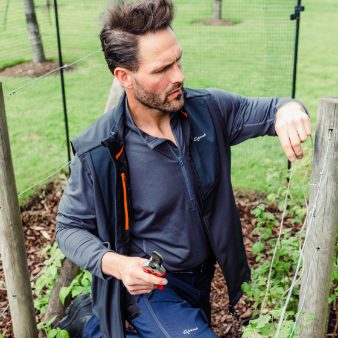The gentle approach to Mary and John Thurston’s home ‘Rocklands’ in Gloucestershire is via a serpentine metalled driveway that weaves gently through camelias, rhododendrons, and mature sweet chestnuts. Access to the house, an attractive stuccoed villa of around 1820, is up several steps, and through a portico supported by doric columns. It is here that the desire to enter the home should be resisted; an about turn will greet you with a view not to be forgotten. As the ground drops away your eyes are taken across treetops, over the spire of the 13th century church of St Mary, and onwards to the glistening silver thread of the River Severn and the upright stanchions of the first Severn bridge crossing.
When your eyes have had their fill of the panorama a closer feature comes into focus. A carved human figure climbing a ladder has been mounted onto the 30-foot trunk of a blue cedar. John commissioned a local artist to carry out the work and ‘Jacob’ as it is now referred to is just one of many sculptures that have found a home throughout the grounds.
Back on the ground the front garden is tiered, and the upper beds planted with euphorbias, heucheras, daylilies, and Spiraea. New steps are currently being constructed to gain access to the lower levels. It’s here that a level plateau with more planting leads down to a more relaxed area of the garden where ‘Jacob’ resides, and the grass populated with wildflowers has been left to grow long. On the far right, a long border has been planted with Ligularia ‘Desdemona’, Acanthus, Salvias, Baptisia, and Persicaria ‘Red Dragon’, and the wall behind is clothed in the violet rambler ‘Veilchenblau’, as well as clematis, and the fascinating wall shrub Actinidia kolomikta with its pink ‘paint-dipped’ leaves. A collection of ornamental trees has been planted nearby and includes some impressive Cornus kousa cultivars.
A quick detour back up towards the house takes you to the greenhouse and productive vegetable garden, an area of around 30 metres by 10 metres, planted with potatoes, runner beans, and sweetcorn as well as a range of sweet peas, alstromerias, sweet williams, and other flowers for cutting. A fruit area is devoted to the production of raspberries, gooseberries, redcurrants, blackcurrants, and mulberries.
Looping around and back up the driveway, a clearing is now the home of a magnificent chainsaw-sculpted bench in the form of a hand holding a scooped seating area. Carved from the trunk of a huge fallen beech, the bench is only a few yards from the site of the tree's original demise.
To the right of the house a beautifully planted pond area is fed by water cascading down from an upper rill. Large stones and boulders act as a backdrop and an attractive weeping Picaea abies flows over the nearby retaining wall and, at the top ,a weeping Cercis leads on to an area of paving with a sculpted female form sitting under a reclaimed stone archway. A path leads up into the former tennis court, now an interesting ‘gravel’ garden, with poppies thriving in the poor soil and a central metal arbour surrounded by low level planting of Allium cristophii, lavender, and nepeta. Steps lead up to the former tennis pavilion now a charming summer house with well stocked rose beds to either side. A mature orchard area to the right has plums, greengage and medlar complete with a flock of sculpted lifesize sheep.
Dropping back down towards the house you pass through an archway planted with a delightful pink rose. Inspired to find the same plant after a visit to New Zealand, Mary discovered that the rose ‘Pierre de Ronsard’, a climber with an unusual touch of green to the double old fashioned type flowers, was known as ‘Eden Rose’ in the UK. More borders in this area have been planted with geraniums, salvias, lupins, Veronicastrum, monkshood, and Penstemon.
After more than 20 years of developing the garden Mary and John are showing no signs of sitting back and accepting it as a finished project. Planting for interest throughout the year has been added with heleniums, asters for the late summer and autumn, and bulbs for early spring and summer. Their love of sculpture will undoubtably continue to fill well-chosen spots (they have open days for sculpture workshops) and with so many different hidden areas the garden will continue to present endless new possibilities for planting and experimentation.














